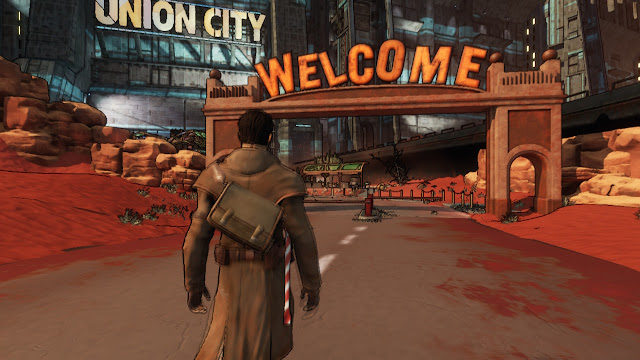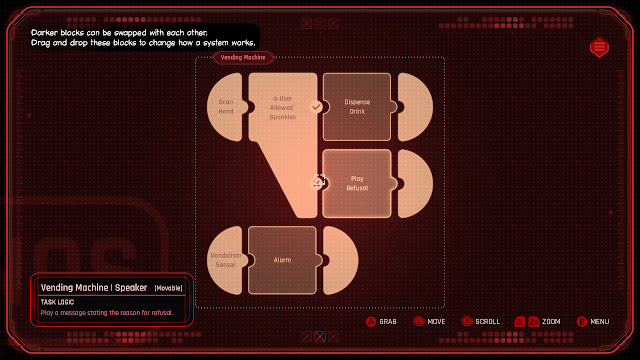BRAVE NEW PERSPECTIVE
Also for: iPad, iPhone, Linux, Macintosh, Playstation 4, Playstation 5,
tvOS, Windows, Xbox One, Xbox Series
Just for still being around, Revolution Software should get a lifetime
achievement award. The British studio got founded and rose to fame
in the 90:s with games like Broken Sword: Shadow of the Templars and
Beneath a Steel Sky. Their expertise is point-and-click adventures, a
genre that rose to prominence in the early 90:s, not long before it faded
away. I loved these kind of games back then, because they were the only ones that put
storytelling at the forefront. When other genres with more exciting gameplay started to adopt adventure game traits - mainly story and dialogue choice - the point-and-click games quickly became redundant. Ever since, new ones have been released but to very little fanfare. Today, the genre is very niche.
Through changing times, Revolution has stuck to their guns like an old
cowboy who won't accept that the Wild West is over. They still make adventure
games with the same sort of gusto storytelling and puzzle-centric gameplay
they had in their 1992 debut, Lure of the Temptress. For that reason
alone, I try to buy all their games upon release. It's not like I still
absolutely love their games, it's the studio and their uncompromising
philosophy that I love. I want Revolution to keep doing what they're doing, in
defiance of all trends, studio closures and layoffs, and soldier on forever.
They feel like the last vestige of the adventure gamer I once was.
Previously, Revolution has been at their best when they've stuck to their
traditions, like mouse controls, side perspective and a streamlined
point-and-click interface. That's why I'm so surprised to like Beyond a Steel Sky about as much as any of their older classics. It looks entirely different. The interface isn't point-and-click anymore. Instead it adopts a third-person view from behind the
shoulder, as if it was an action adventure, and implements direct controls to
support it. Yet the gameplay remains the same.
In my experience, toying with perspective and controls in adventure games has
always spelt disaster. That was certainly true of Revolution's own worst
releases, Broken Sword: The Sleeping Dragon and
Broken Sword: The Angel of Death. In Beyond a Steel Sky, however,
they've found a neat workaround. Inventory puzzles are relatively sparse, logical and easy. Instead they've experimented with another way to design puzzles, based on
rudimentary hacking and programming logic.
To solve problems, you often need to whip out your hacking device and alter
the programming functions of machines or robots. Do you want a free soda from
a vending machine? Try hacking the thing and rearrange its functions to make
it spit out a can when you're out of credits. It's exciting to see a game of a
genre often reviled for moon logic actually lean into logics, of the
programming kind, to make puzzles. They're quite straightforward and easy to crack. I'd almost say they're too easy, but this is a nice first step away from pixel hunts
and trial-and-error.
The game takes place in an interesting setting. Beyond a Steel Sky is a
belated sequel to the well-respected 1994-release Beneath a Steel Sky. In that
game, you controlled Robert Foster, a man with a mysterious past, in his quest
to liberate a dystopian metropolis, Union City, from a tyrannical regime. The
scenario echoed of George Orwell's classic novel 1984,
a frightening depiction of a society under constant surveillance by its rulers. The game's most unfortunate design decision was the tone,
established by the comedic dialogue and upbeat music, which ruined the oppressive atmosphere.
This sequel leans into another dystopian inspiration, namely
Brave New World by Aldous Huxley, a faux-utopian setting better
suited to the lighthearted tone. Ten years have passed. Foster returns to
Union City from his temporary home in the desert wasteland, called the Gap, in
search of a boy who was kidnapped. Much has changed in the city. At the
end of the first game he left his robot sidekick, Joey, in charge. Now Robert
finds that people worship Joey like a god.
Things seem better, people are happy, but something about the sunshine-and-rainbows
facade feels off, as if it's forced upon them. Joey is rumored to have left
the city, wandering into the wasteland never to be seen again. A council of
five ministers has taken his place and rules the city. In your search for
the kidnapped boy you discover a new form of oppressive government, working secretly to
control the population.
The story is good, at least on par with the predecessor's, with a great final
stretch of scenes that I'll not forget anytime soon. Many charismatic
characters parade through the story, with their own quirks you can exploit to
solve puzzles. My favorite involves a pretentious poet, who's invited a robot
to perform a poetry reading at a grand event. To create a distraction, you can
tinker with the droid's settings, resulting in a hilarious scene. The
celshaded character design envelops the story in a fine, comic book artstyle
that fits their personalitites and the tone of the storytelling.
The free camera gives you a good view of the city and its many skyscrapers and
factories with sky-high chimneys. And for once in a Revolution game, the world feels inhabited. NPC:s walk the streets and plazas, gossiping and
interacting with their environment. Gang-gang vultures loiter in the vicinity,
ready to gobble up knackwurst leftovers. The skies are sunny and clear, the
colors have returned to the city and some plants are growing, but much of it
feels as artificial as the smiles on people's faces.
The story, puzzles and setting rank among Revolution's finest, elevated
further by Dave Gibbon's great art design. Unfortunately, the game also
demonstrates some rust and cobwebs, mainly in the controls. Even when running,
Robert moves with the pace and grace of an arthritic ox. Ordinary walking
speed is so slow it's practically useless, and shouldn't even be an option.
This is one of the pitfalls of changing control method in adventure games.
You're meant to play them mostly by thinking, but direct movement is too busy. It interferes
with your thought processes. Luckily, the areas are small enough to make this
a minor nuiscance.
Adventure games usually require the patience of a saint. In Beyond a Steel
Sky, this is no more true than in dialogue. Every character has droves of
things to say, and they repeat the most important hints with almost every
choice in the dialogue wheel. Add to that a lore dump or joke at every
opportunity and you get conversations that go around in circles. When a
subject matter is exhausted, it gets slightly greyed out and italicized, but
to reach that point you need to go through variances of the same things being
said over and over.
That being said, the dialogue can at times be funny. Since he's on the cover
art, I'll not consider this a spoiler: Joey eventually returns as a sidekick, and
the banter between Robert and the little droid is as enjoyable as ever.
It's as if no time has passed. Beyond a Steel Sky is one of few games that
actually make a bit of gameplay out of dialogue. In one scene you're being
interrogated while someone in the background tries to give you the correct
answers through pantomime. It's a funny moment, one that got me on-board after
starting the game somewhat skeptical.
I learned to live with the flaws, and I like the forward momentum of the
story. It has a clear subgoal every step of the way towards the intriguing
ending, and avoids annoying detours. The puzzles are among the best I've seen
in a game of this ilk. Talking to people often inspires ideas to try as
solutions. The inventory puzzles are straightforward. The wise decision to
limit the "use"-command to important objects basically removes all trial-and
error.
The hacking puzzles are fun to mess around with. Even if you fail to solve the
puzzle, hacking affects the world in some capacity. You might change the
behavior of a robot, or change the ad displayed on a hologram. How about
preventing a pompuous asshole from entering the VIP-lounge of a café? Only a
couple of puzzles got me annoyed, like an early contrivance involving a
cleaning droid and a girl balancing on a ledge on the side of a building. It
involved a lot of waiting around for the droid to perform its actions.
But overall, Beyond a Steel Sky is a surprisingly fine return to Union City.
Without being excluding to newcomers, it expands upon the events from the first game in
an intriguing way. It may belong to a ancient cult genre, but the hacking
puzzles are inventive and demonstrate a way forward. The genre holds limited
potential in this age, but Beyond a Steel Sky is about as good as one could
hope for.
Most of all I think Revolution Software should take a bow. I'm overjoyed to
see them still exist. It's the only studio from my adolescence left intact,
making the same kind of games I used to love with the same guy in charge (Charles Cecil). Although they made a couple of failed compromises in the past, they've
never sold out. They're in it for their desire to tell stories. Their games
may no longer shake my world, but they keep rocking my past.












Comments
Post a Comment